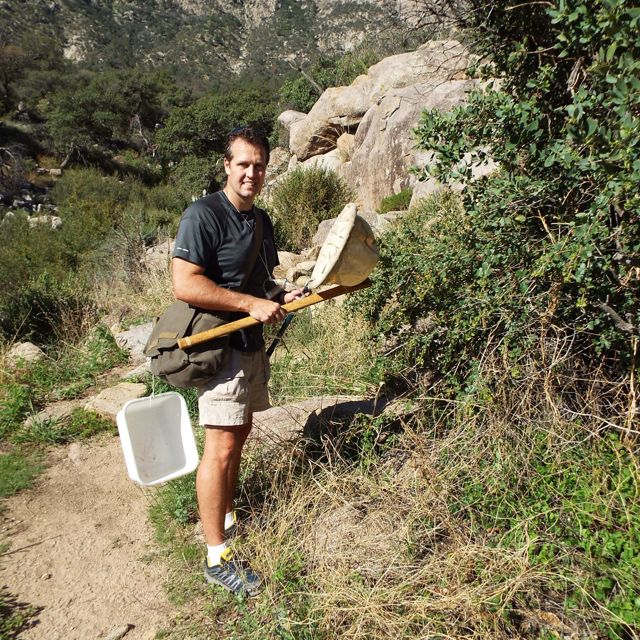Collecting Insects
Insects can be found practically anywhere, but the most important thing is to pay close attention to your surroundings—insect scouting is an excellent way to improve your observational skills—as well as test your patience! To make things easier, you’ll want to bring along some collecting gear.
Collecting Equipment

Many of these tools are simple and inexpensive to make or purchase. Your collecting kit should include:
- Collecting vials
- Insect nets
- Aspirator
- Bucket
- Killing jars
- Pencil and memo pad
- Insect guide
Collecting Vials
Plastic vials with easy pop-off lids are a great tool for capturing medium to small insects on the go. Repurposing medicine bottles or other small sealable containers will also work—just remember to slip a piece of paper with your collecting information (the date, location found, etc.) inside the vial. The captured insect can then be transported back and frozen at your convenience.
Insect Nets
Insect nets come in a variety of sizes and fabric weights depending on their purpose. Sweep nets are made of a durable, heavy fabric that can withstand being swept through grasses and other vegetation. Butterfly nets are more lightweight and are meant to capture delicate flying insects with less risk of damaging their wings. Beat nets are held under a tree or shrub—when the foliage is shaken, insects will fall into the wider, shallow net and can then be examined or collected. Aquatic nets are heavy-duty, built for scraping along the bottom of streams or shallow pools of water.
Aspirators
An aspirator is an extremely convenient collecting tool that fits easily into a bag or pocket. It’s designed to be effective for sucking up small insects.
Buckets
A bucket can be a helpful multipurpose tool while collecting. They can also substitute as a beat net, containing insects that fall from shaken foliage. A fine wire mesh inside the rubber stopper prevents accidentally sucking up most particulate matter.
Killing Jars
This tool is designed to kill insects collected in the field when a freezer is not an option. A wide-mouth jar with a tight sealing lid–such as a mason jar—can be filled with about an inch of prepared Plaster of Paris and allowed to sit and harden overnight. A few drops of ethyl acetate (non-acetone nail polish remover is made of this) can then be put on the plaster. Insects placed inside this sealed jar will quickly die due to the vapors.
Other Methods for Capturing Insects

Light Traps
Light traps are a great way to collect insects at night fall. Simply suspend a white sheet against a wall or across a tree and illuminate it with a UV light source outside. Moths, beetles, and a variety of other insects active at night will be attracted to the sheet.
Pitfall Traps
Pitfall traps are ideal for collecting ground-dwelling insects. To make a pitfall trap, you’ll want to bring a hand shovel along to dig an appropriately sized hole to insert a plastic cup so its rim is level with the ground. Fill the cup with about 2 inches of propylene-glycol based antifreeze (do NOT use antifreeze that contains ethylene glycol as it is poisonous to wildlife and pets). A cover, like an overturned plastic plate secured and elevated slightly above the trap with rocks, will help prevent larger creatures from accidentally falling in.
Pan Traps
Like pitfall traps, pan traps are generally used to collect insects crawling along on the ground. It comes with the added bonus of capturing insects attracted to the color of the pan. Simply fill the base of the shallow pan with water and a drop or two of liquid soap (it helps to break the surface tension of the water so the insect can’t escape). Experiment with different colors of plastic pans (yellow, red, white, etc) and see what you find!
Bait Traps
Various insects like beetles and moths can be attracted by bait set on the ground or suspended by ropes. It can be as simple as plopping sliced overripe fruit on a lid on the ground. To attract flying insects, you can stuff a tube sock with bait like fruit or raw hamburger and suspend it in the air for a few days. The smellier the bait, the better!


